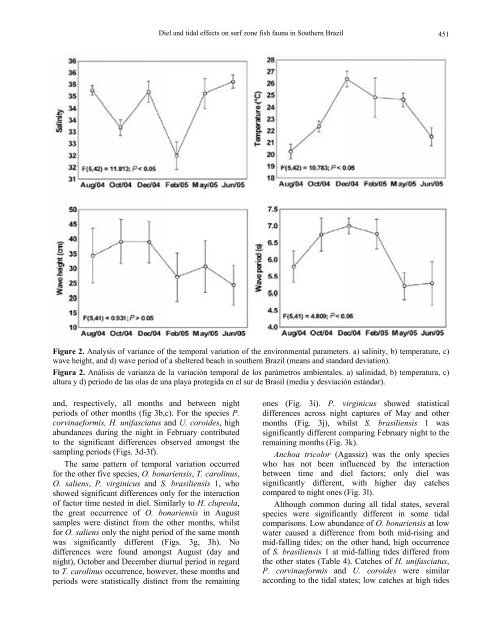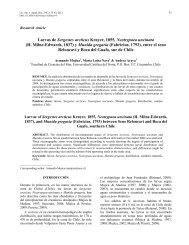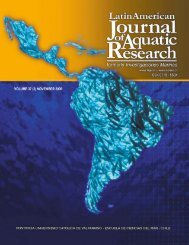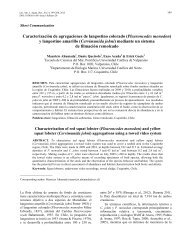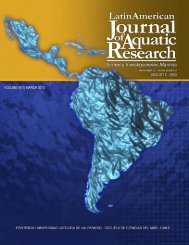Portada LAJAR.psd - Latin American Journal of Aquatic Research
Portada LAJAR.psd - Latin American Journal of Aquatic Research
Portada LAJAR.psd - Latin American Journal of Aquatic Research
Create successful ePaper yourself
Turn your PDF publications into a flip-book with our unique Google optimized e-Paper software.
Diel and tidal effects on surf zone fish fauna in Southern Brazil<br />
Figure 2. Analysis <strong>of</strong> variance <strong>of</strong> the temporal variation <strong>of</strong> the environmental parameters. a) salinity, b) temperature, c)<br />
wave height, and d) wave period <strong>of</strong> a sheltered beach in southern Brazil (means and standard deviation).<br />
Figura 2. Análisis de varianza de la variación temporal de los parámetros ambientales. a) salinidad, b) temperatura, c)<br />
altura y d) periodo de las olas de una playa protegida en el sur de Brasil (media y desviación estándar).<br />
and, respectively, all months and between night<br />
periods <strong>of</strong> other months (fig 3b,c). For the species P.<br />
corvinaeformis, H. unifasciatus and U. coroides, high<br />
abundances during the night in February contributed<br />
to the significant differences observed amongst the<br />
sampling periods (Figs. 3d-3f).<br />
The same pattern <strong>of</strong> temporal variation occurred<br />
for the other five species, O. bonariensis, T. carolinus,<br />
O. saliens, P. virginicus and S. brasiliensis 1, who<br />
showed significant differences only for the interaction<br />
<strong>of</strong> factor time nested in diel. Similarly to H. clupeola,<br />
the great occurrence <strong>of</strong> O. bonariensis in August<br />
samples were distinct from the other months, whilst<br />
for O. saliens only the night period <strong>of</strong> the same month<br />
was significantly different (Figs. 3g, 3h). No<br />
differences were found amongst August (day and<br />
night), October and December diurnal period in regard<br />
to T. carolinus occurrence, however, these months and<br />
periods were statistically distinct from the remaining<br />
451<br />
ones (Fig. 3i). P. virginicus showed statistical<br />
differences across night captures <strong>of</strong> May and other<br />
months (Fig. 3j), whilst S. brasiliensis 1 was<br />
significantly different comparing February night to the<br />
remaining months (Fig. 3k).<br />
Anchoa tricolor (Agassiz) was the only species<br />
who has not been influenced by the interaction<br />
between time and diel factors; only diel was<br />
significantly different, with higher day catches<br />
compared to night ones (Fig. 3l).<br />
Although common during all tidal states, several<br />
species were significantly different in some tidal<br />
comparisons. Low abundance <strong>of</strong> O. bonariensis at low<br />
water caused a difference from both mid-rising and<br />
mid-falling tides; on the other hand, high occurrence<br />
<strong>of</strong> S. brasiliensis 1 at mid-falling tides differed from<br />
the other states (Table 4). Catches <strong>of</strong> H. unifasciatus,<br />
P. corvinaeformis and U. coroides were similar<br />
according to the tidal states; low catches at high tides


